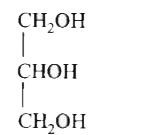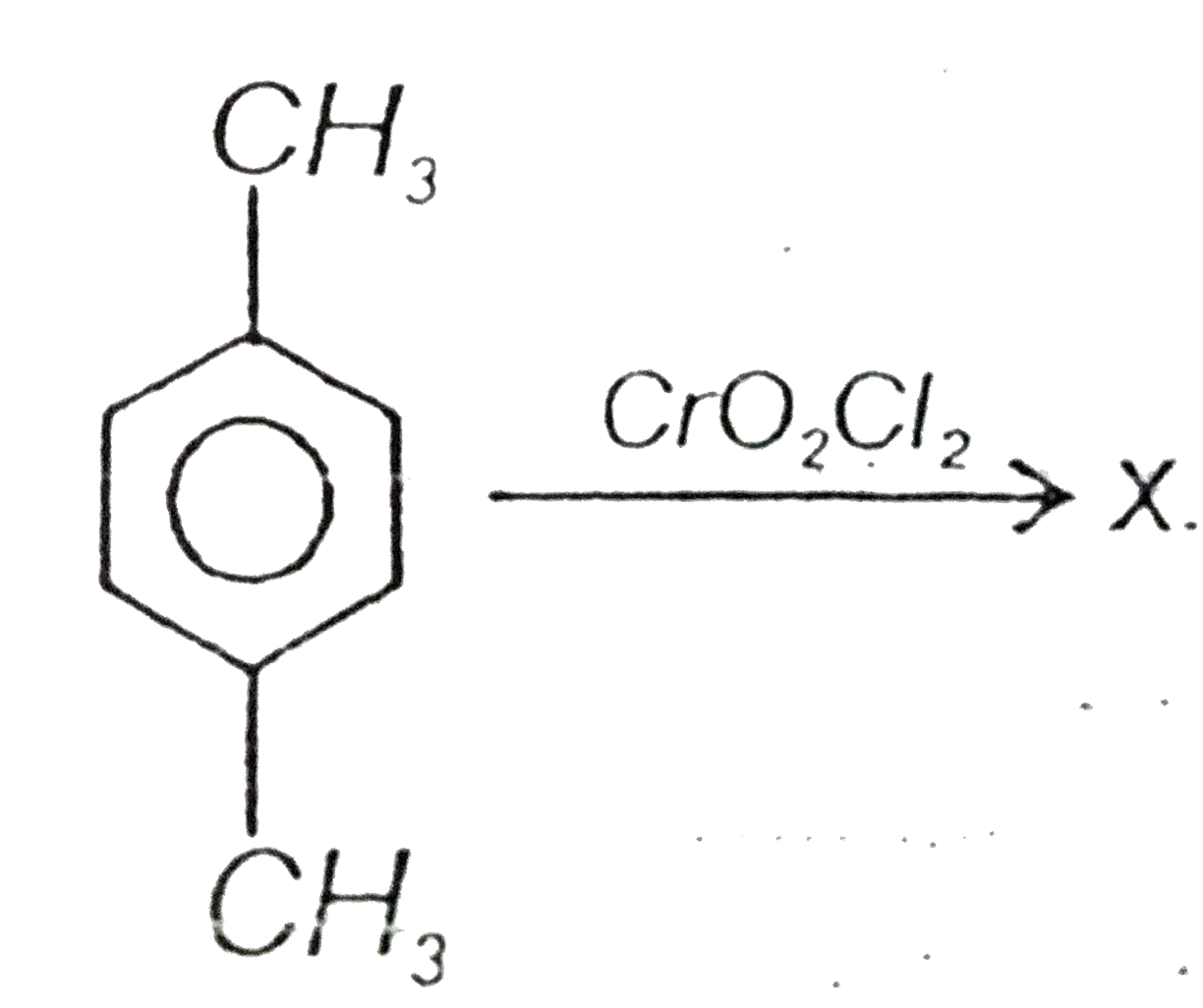Consider the following sequence of reactions
CH3CH=CH2Cl2−−→700KANa2CO3−−−−−−−→420K,12atmB(i)HOCl−−−−−→(ii)NaOhC
Compound 'C' is

CH3CHCOONa∣OH
HOCH2−CH=CH2
CH3CHCOCl∣OH
The correct Answer is:a
To solve the problem step by step, we will analyze each reaction in the sequence provided.
Step 1: Reaction of CH₃CH=CH₂ with Cl₂
- Starting Compound: CH₃CH=CH₂ (Propene)
- Reagent: Cl₂ (Chlorine gas) at 700 K
- Reaction Type: Electrophilic addition
- Mechanism: The double bond (π bond) in propene attacks the Cl₂ molecule, leading to the formation of a cyclic chloronium ion. The Cl⁻ ion then attacks the more substituted carbon, resulting in a vicinal dichloride.
Product A:
- The product formed is 1,2-dichloropropane (CH₃CHClCH₂Cl).
Step 2: Reaction of A with Na₂CO₃
- Starting Compound: A (1,2-dichloropropane)
- Reagent: Na₂CO₃ (Sodium carbonate) at 420 K and 12 atm
- Reaction Type: Elimination reaction
- Mechanism: The base (Na₂CO₃) abstracts a proton from the less hindered side (the CH₂ group), resulting in the elimination of one of the Cl atoms and forming a double bond.
Product B:
- The product formed is propene (CH₃CH=CH₂) again.
Step 3: Reaction of B with HOCl
- Starting Compound: B (Propene)
- Reagent: HOCl (Hypochlorous acid)
- Reaction Type: Electrophilic addition
- Mechanism: The π bond in propene attacks the electrophilic Cl in HOCl, leading to the formation of a chlorohydrin.
Product C:
- The product formed is 1-chloro-2-propanol (CH₃CH(Cl)CH₂OH).
Step 4: Reaction of C with NaOH
- Starting Compound: C (1-chloro-2-propanol)
- Reagent: NaOH (Sodium hydroxide)
- Reaction Type: Nucleophilic substitution
- Mechanism: The hydroxide ion (OH⁻) acts as a nucleophile and attacks the carbon bonded to the chlorine, leading to the substitution of the Cl atom with OH.
Final Product C:
- The final product is 2-propanol (isopropanol, CH₃CHOHCH₃).
Conclusion
The compound 'C' is 2-propanol (isopropanol).
---
- Starting Compound: CH₃CH=CH₂ (Propene)
- Reagent: Cl₂ (Chlorine gas) at 700 K
- Reaction Type: Electrophilic addition
- Mechanism: The double bond (π bond) in propene attacks the Cl₂ molecule, leading to the formation of a cyclic chloronium ion. The Cl⁻ ion then attacks the more substituted carbon, resulting in a vicinal dichloride.
Product A:
- The product formed is 1,2-dichloropropane (CH₃CHClCH₂Cl).
- Starting Compound: A (1,2-dichloropropane)
- Reagent: Na₂CO₃ (Sodium carbonate) at 420 K and 12 atm
- Reaction Type: Elimination reaction
- Mechanism: The base (Na₂CO₃) abstracts a proton from the less hindered side (the CH₂ group), resulting in the elimination of one of the Cl atoms and forming a double bond.
- The product formed is propene (CH₃CH=CH₂) again.
- Starting Compound: B (Propene)
- Reagent: HOCl (Hypochlorous acid)
- Reaction Type: Electrophilic addition
- Mechanism: The π bond in propene attacks the electrophilic Cl in HOCl, leading to the formation of a chlorohydrin.
- The product formed is 1-chloro-2-propanol (CH₃CH(Cl)CH₂OH).
- Starting Compound: C (1-chloro-2-propanol)
- Reagent: NaOH (Sodium hydroxide)
- Reaction Type: Nucleophilic substitution
- Mechanism: The hydroxide ion (OH⁻) acts as a nucleophile and attacks the carbon bonded to the chlorine, leading to the substitution of the Cl atom with OH.
- The final product is 2-propanol (isopropanol, CH₃CHOHCH₃).
The compound 'C' is 2-propanol (isopropanol).
Topper's Solved these Questions
- BOOK - DISHA PUBLICATIONCHAPTER - HYDROCARBONSEXERCISE - EXERCISE -1 : CONCEPT BUILDER (TOPIC WISE )80videos
HYDROCARBONS
- BOOK - DISHA PUBLICATIONCHAPTER - HALOALKANES AND HALOARENES EXERCISE - Exercise -2 : Concept Applicator28videos
HALOALKANES AND HALOARENES
- BOOK - DISHA PUBLICATIONCHAPTER - HYDROGENEXERCISE - Exercise - 2 : Concept Applicator30videos
HYDROGEN
Similar Questions
Complete the following reactions:
(i) CH3−CH2−O−CH3| C | CH3−CH3−HIHeat−−→
View SolutionGive the structures of A,B and C in the following reactions :
(i) CH3BrKCN−−→ALiAlH4−−−→BHNO2−−−−−−→273KC
(ii) CH3COOHNH3−−−−−→ΔABr2+KOH−−−−−−→BCHCl3+NaOH−−−−−−−−−→C
(iii) CH3CNH2O/OH−−−−−−−→ANH3−−−−−→ΔBBr2+KOH−−−−−−→CView Solution
Knowledge Check
- Question 1 - Select One
Identify the product 'D' in the following sequence of reactions:
CH3−CH2−CH2−ClAlc. KOH−−−−−→Δ'B'HBr−−→CNa−−→EtherDA2,2-dimethylbutaneB2,3-dimethylbutaneChexaneD2,4-dimethylpentane - Question 2 - Select One
In the following sequence of reactions, the compound C formed would be
CH3−CH| NH2−CH3HNO2−−−→H2OA[O]−−→BCH3MgI−−−−−→H+/H2OCA1, 1 - DimethylethanolBButanol - 1CButanol - 2D2 - Methyl - propanol - 1 - Question 3 - Select One
H2C=CH−CH3∣C∣CH3−COOHNaOH−−−−→CaO/ΔXwill be
AH3C−CH=CH3∣C−CH3BH2C=CH−CH3∣C∣H−CH3CH3C−CH=CH3∣C−CH2OHDH3C=CH−CH3∣C∣CH3−COONa
Complete the following reactions:
(i) CH3−CH3∣C∣Cl−CH2CH3alcKOH−−−−→ΔAO3−−−−−→Zn/H2O(B+C)
(ii) CH3ICH−CH3alcKCN−−−−→A(i)SnCl2/HCl−−−−−−−−−−−−→(ii)H2O.OH.H2O2B
(iii) HCNHCl/AlCl3−−−−−−→A(i)C6H6Δ−−−−−−−−−−→(ii)(H2O)/H−B
(iv) View Solution
View SolutionComplete the following reactions sequence:
CH3−O∣∣C−CH3(i)CH3MgBr−−−−−−−−→(ii)H2O(A)Na metal−−−−−→Ether(B)CH3−Br−−−−−→(C)View SolutionProducts B and C in the following reaction are
CH3−C∣ClH−CH3∣CH−CH3KOH(alc.)−−−−−−−→A(i)O3−−−−−−−−−−→(ii)H2O/ZnB+CView SolutionCH3−F∣C∣CH2CH3−CH2−Cl∣C∣CH2CH3−CH3
The IUPAC name of this compound isView SolutionConsider the following reaction
CH3−C∣DH−C∣CH3H−CH3−∗Br→∗X+HBr
The structure of ∗X isView Solution

